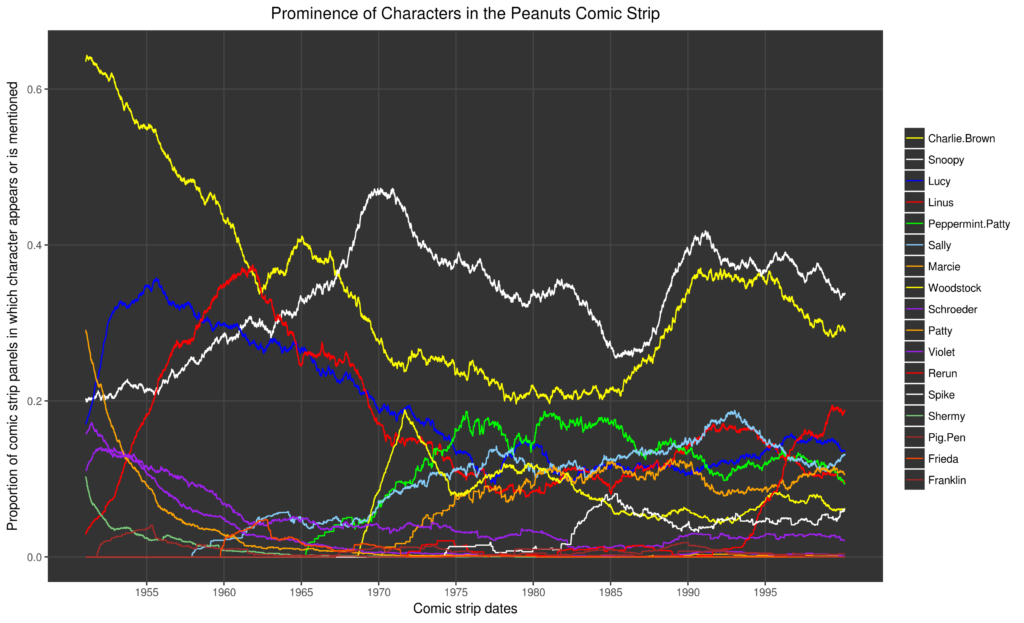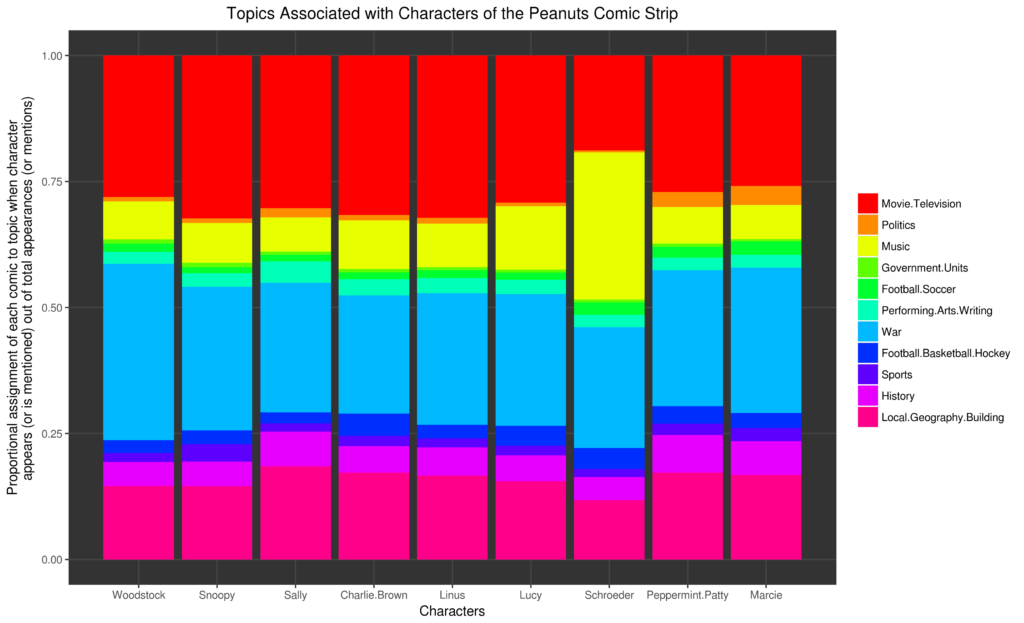“Ohhhh, you didn’t tell me you were gonna kill it!”
Like so many of us, I have fond memories of growing up with Peanuts — Charlie Brown, Snoopy, Lucy, Linus, Sally, and the rest of the gang. But Peanuts had already been around for a long time by then; my parents grew up with it, too! For me, the characters always had their distinctive quirks: Snoopy at his typewriter; Lucy’s “football gag” with Charlie Brown; Marcie calling Peppermint Patty, “Sir.” I never appreciated how much Peanuts had changed over its 50 years in newspapers. Did you know that the characters used to look like this?
It wasn’t just the characters’ appearances that changed. This article by Sarah Boxer in The Atlantic discussed how Charles Schulz shifted the comic strip’s focus from the characters’ angst and their web of relationships to Snoopy’s carefree fantasy world. “By 1975, Snoopy had replaced Charlie Brown as the center of the strip,” Boxer pronounced.
How fascinating. How else did Peanuts change over time? Which characters were most important? How strong were those relationships?
Thankfully, these questions are relatively easy to answer in our internet-based age. GoComics has published every Peanuts strip online from the very first to the very last. Read through, enjoy them all, and answer the questions for yourself.
But as a trained scientist, I wanted to do more than just read and enjoy all of Peanuts. I wanted to measure it!
Character Prominence
Below is a plot of the prominence of the major Peanuts characters over the course of the comic strip from its start in 1950 to its end in 2000. “Prominence” refers to the proportion of a strip’s panels in which a character appears or is mentioned. For example, if a strip has four panels and Sally appears in all of them, then she is probably important to the strip’s story. If Snoopy appears in only one of those panels, he is probably not as important. The lines across the plot are rolling averages, which make the lines less jiggly and the trends easier to see.

Boxer’s pronouncement was correct: Snoopy’s prominence (the high white line) surpasses Charlie Brown’s prominence (the high yellow line) by the 1970s. In fact, it looks like Snoopy overtakes Charlie Brown in about 1967.
Charlie Brown’s prominence is very high at the start of the comic strip and plunges as new characters are introduced. From the late 1950s to 1970, the strip is primarily about Charlie Brown, Lucy, Linus, and Snoopy.
As that shift toward Snoopy’s own adventures occurs in the 1970s, Woodstock (the lower yellow line) becomes more prominent. Also in the 1970s, Peppermint Patty (the bright green line) emerges as the third most prominent character behind Snoopy and Charlie Brown. Sally’s prominence (the light blue line) peaks in the early 1990s, and that surging red line in the late 1990s represents Rerun, Lucy’s and Linus’s younger brother.
Clearly, Charlie Brown and Snoopy are the major stars throughout the strip with several other characters taking their turns as the next most prominent characters.
Character Relationships: Absolute Importance
What about that web of relationships? Take a look:

Each circle represents a character. The larger a character’s circle, the more comic strips that character appeared in. The major characters’ circles have colors that correspond to the colors of their rolling averages in the character prominence plot above. The minor characters all have gray circles.
The gray lines that link the circles indicate the strengths of the relationships among the characters. The more comic strips where the two characters appear together, the thicker the line linking them.
Charlie Brown and Snoopy are at the top, and the link connecting them looks like the thickest of all. That shows that they appear a lot together; their relationship is the biggest one in the comic strip.
Charlie Brown, Snoopy, Lucy, and Linus all have really thick links with each other, showing how important their relationships are to the strip.
Sally has an important relationship to her brother Charlie Brown, and some fairly important ones with Linus and Snoopy, but not much beyond those.
Peppermint Patty and Marcie have a really strong relationship with each other, and some moderate ones with Charlie Brown and Snoopy, but not much else. Patty and Violet show a similar pattern.
Woodstock has a really strong relationship with Snoopy, but that’s his only important one. Schroeder has moderately important relationships with Lucy, Charlie Brown, and Snoopy.
Character Relationships: Relative Importance
That tells us how important those relationships were to the comic strip overall. But how important were those relationships to the characters? For example, if two characters rarely appeared in the strip but they always appeared with each other, then it seems that their relationship was important to them, even if it wasn’t that prominent in the entire strip. Let’s look at that below.

Now the thickness of the links indicates the proportion of the characters’ appearances where they appear together. For example, let’s pretend we’re looking at only 20 comic strips. Snoopy appears in 4 without Lucy, Lucy appears in 5 without Snoopy, and they appear in 3 together. That means Snoopy or Lucy or both appear in 12 strips total. The proportion of their appearances where they appear together is 3 divided by 12, which is 0.25, or 25% (not 3 divided by 20, which is the math we were doing previously).
This gives us a rather different look at the characters’ relationships. Minor characters (gray circles) who often appear together can now have thick links.
The thickest link now belongs to Andy and Olaf, two of Snoopy’s brothers. They spent much of the 1990s lost together while looking for their brother Spike’s home.
Out of the major characters, it looks like Peppermint Patty and Marcie have the strongest relationship, which isn’t surprising. They often appeared together separately from the other characters.
Topics
Through Peanuts, Schultz touched on a great many topics, like war, movies, sports, feminism, economic class, religion, music, politics, literature, law, and failure. How did the mix of these topics change over time? Did different characters talk about different topics?
We can use a computerized technique called topic modeling (specifically, latent Dirichlet allocation) to classify Peanuts comic strips into different categories of topics. The selection of topics is based on the contents of Wikipedia articles. Here’s the timeline of topics:

Many of the topics derived from Wikipedia were not clearly defined or were about editing Wikipedia itself. Those topics are all shown as gray lines because we can’t glean any useful information from them. The more informative topics are shown as colored lines and are subjectively labeled in the timeline’s legend.
Even the informative topics are not very distinct or specific, but we can still pick out some trends. The high ranking for the War topic (light blue line) is partly due to Snoopy’s fantasy life as the World War I Flying Ace and other similar personas. Snoopy started as the Flying Ace in the mid-1960s, which probably accounts for the surging War topic line from about 1963 to 1967. Remember that Snoopy’s prominence in general was also increasing at that time, as we showed in the Character Prominence section above.
The Movies and Television topic (red line) also ranks highly. Peanuts often mentioned movies or television shows or associated celebrities. But the reason for the surge in this topic from the mid-1980s through the 1990s is probably the increasing tendency for the characters to sit in front of the television.
Surprisingly, the three sports-related topics rank low in the topic timeline. Perhaps a more refined and detailed analysis would reveal some more interesting trends for sports.
The decline of Music (yellow line) as a topic through the 1950s and into the 1960s might be because of Schroeder’s declining prominence during that time, as we showed in the Character Prominence section above.
With both Snoopy and Schroeder, we noticed that the topics might be connected with particular characters. Let’s take a look at that:

The plot above shows the proportions of each character’s appearances that are associated with each topic.
The most notable difference is that Schroeder clearly has a stronger association with Music (yellow) than any other character. Beyond that, there’s not much difference among the characters.
Conclusion
That was a fun re-visiting of my childhood love of Peanuts, and I hope you’ve enjoyed exploring and measuring it as much as I have! Since we were just talking about the topic of music, let’s conclude by highlighting a lovely song from Snoopy!!! The Musical, which doesn’t get nearly as much attention as its more famous predecessor.
For details on how the analysis was done, start here.
